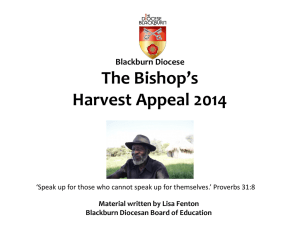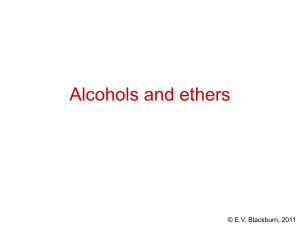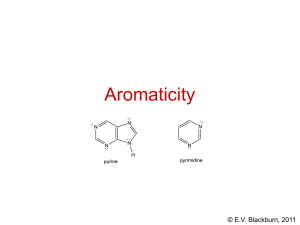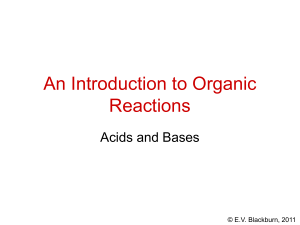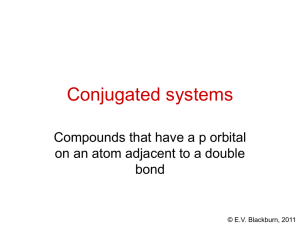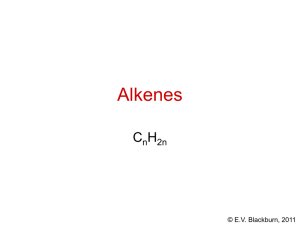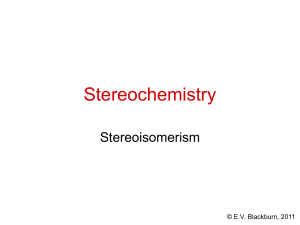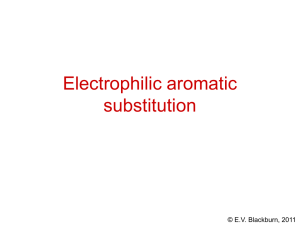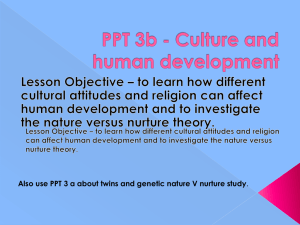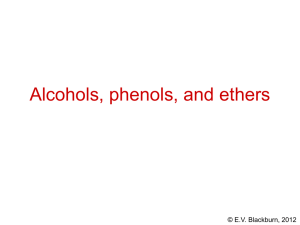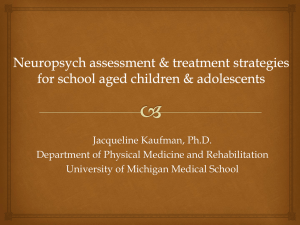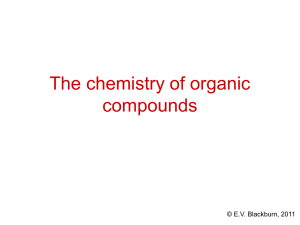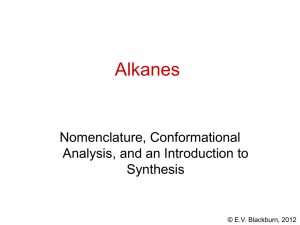Carbohydrates
advertisement
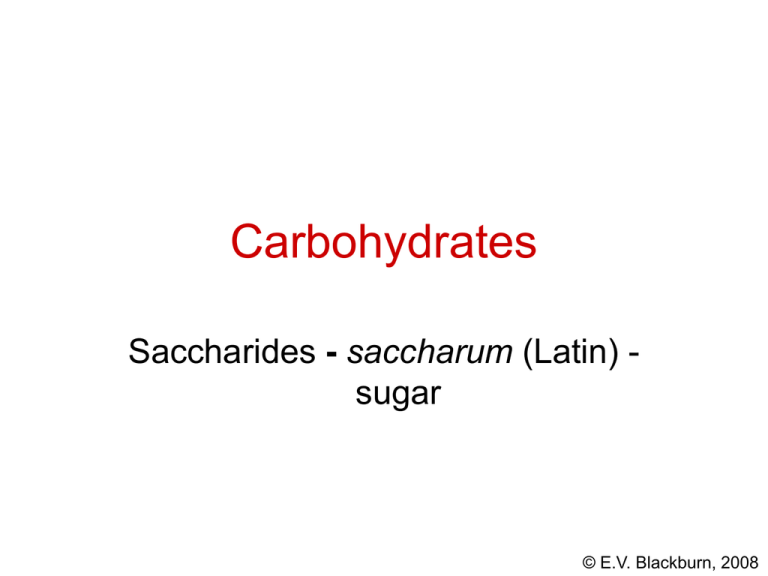
Carbohydrates Saccharides - saccharum (Latin) sugar © E.V. Blackburn, 2008 Photosynthesis Carbohydrates are synthesized by green plants via the process of photosynthesis. This involves the chemical combination of carbon dioxide and water which results from the absorption of visible light. The detailed mechanism of the transformation is not fully understood. There are many enzyme-catalyzed reactions which take place, the first of which involves absorption of light by the extended system of chlorophyll. h xCO 2 + xH 2 O (CH 2 O) x + xO 2 chlorophyll © E.V. Blackburn, 2008 Chlorophyll-a CH 2 = C H H 3C N H CH 3 Mg N N CH 2 CH 2 CH 3 N H 3C CH 2 Synthesis - R.B. Woodward, 1960 CH 3 H H O CO 2 CH 3 C=O O CH 2 H 3C H H 3C H © E.V. Blackburn, 2008 Carbohydrate metabolism Carbohydrates “store” solar energy which is released when they are metabolized to give CO2 and water: Cx(H2O)y + xO2 xCO2 + yH2O + energy Much of the energy released is conserved in a new chemical form through reactions that are coupled to the synthesis of adenosine triphosphate from adenosine diphosphate. © E.V. Blackburn, 2008 Carbohydrate metabolism NH 2 N N N adenine N O O H H CH 2 - O-P-O-P-OH OH OH O H H O - O O + HO-P-O - O ADP NH 2 N N - phosphate ion ribose N - N O O O H H CH 2 -O-P-O-P-O-P-O OH OH O H H O ATP - O - O Plants and animals use the conserved energy of ATP to perform energyrequiring processes such as muscle contraction. The energy is released and the ATP hydrolyzed to ADP. - © E.V. Blackburn, 2008 D-glyceric acid CO 2 H H OH CH 2 OH enzymes simple sugars starch cellulose polymers (C 6 H 10 O 5 ) n © E.V. Blackburn, 2008 D-glyceric acid CO 2 H H OH CH 2 OH D???? The letter D designates the absolute configuration of this acid. This pre-dates Cahn-Prelog-Ingold by many years! This system was suggested by Rosanoff in 1906 and works as follows: the configuration is D, if the hydroxyl group of the stereogenic centre is to the right in the Fischer projection formula. If it is to the left, the letter L is used. © E.V. Blackburn, 2008 D, L Sugars CHO H OH CH 2 OH (R)-(+)-glyceraldehyde The configuration of (+)-glyceraldehyde was arbitrarily assigned as (D)! Monosaccharides have the D configuration if the OH group attached to their highest numbered stereogenic centre is to the right in the Fischer projection formula; L is used if it is to the left. In 1951, Bijvoet determined the absolute configuration of L(+)-tartaric acid and hence that of D-(+)-glyceraldehyde. The D assignment was correct! © E.V. Blackburn, 2008 D-Sugars O H HO H H C H OH H OH OH CH 2 OH D-glucose O HO HO H H C H H H OH OH CH 2 OH D-mannose CH 2 OH O HO H H OH H OH CH 2 OH D-fructose Virtually all naturally occurring monosaccharides are D sugars. © E.V. Blackburn, 2008 Epimers Examine D-(+)-glucose and D-(+)-mannose: O H HO H H C H OH H OH OH CH 2 OH D-glucose O HO HO H H C H H H OH OH CH 2 OH D-mannose They only differ in the configuration about one stereogenic centre, C-2. Two diastereoisomers which only differ in the configuration about one stereogenic carbon are called epimers. © E.V. Blackburn, 2008 Epimers O H HO H H C H O OH H H OH OH CH 2 OH D-(+)-glucose HO HO H C H OH H H OH CH 2 OH D-(+)-galactose © E.V. Blackburn, 2008 Classification of carbohydrates “sugars” - the general name used for monosaccharides, disaccharides, oligosaccharides (low molecular weight polymers) and polysaccharides. (saccharum, Latin, sugar) “monosaccharides” - sugars that cannot be hydrolyzed into smaller molecules (monomer units) “aldoses” - sugars with an aldehyde carbonyl group “ketoses” - sugars with a ketone carbonyl group © E.V. Blackburn, 2008 (+)-Glucose • the most abundant monosaccharide • present in the free state in fruits, plants, honey, blood and urine of animals • an aldohexose • C6H12O6 • there are 4 stereogenic centres and therefore 24 (16) optical isomers are possible! All are known! © E.V. Blackburn, 2008 (+)-Glucose CHO * CHOH * CHOH * CHOH * CHOH CH 2 OH O 1 C H H OH HO H H OH H 5 Emile Fischer, at the end of the 19th century, successfully identified glucose among the 16 possible isomers! OH The configuration at C-5 was identical to that of D-(+)glyceraldehyde. CH 2 OH © E.V. Blackburn, 2008 Reactivity of glucose Glucose reduces -Fehling’s solution (Cu(II) in Cu(I)) Tollens’ reagent (Ag(I) in Ag(0)) Glucose is an aldehyde! O H Ag(NH 3)2 + O + Ag O - When it reacts with amines, it does not always form imines (C=N-R). Glucose is not an aldehyde? © E.V. Blackburn, 2008 Reactivity of glucose Aldehydes react with two equivalents of methanol to form dimethyl acetals: H RCHO + 2CH 3 OH R-C-OCH OCH 3 + H 2O 3 Glucose does not form a dimethyl acetals! It forms two different monomethylated derivatives: C 6 H 12 O 6 CH 3 OH (C 6 H 11 O 5 )OCH 3 + H 2O methyl - and -D-glucoside © E.V. Blackburn, 2008 Cyclic glucose O H HO H H C H H H HO H H OH H OH .. OH CH 2 OH O O CH 2 OH D-(+)-glucose H O OH C OH H OH a hemiacetal H O OH © E.V. Blackburn, 2008 Anomers H * OH HO H OH H HO H H OH O HO H *H OH H O OH H H CH 2 OH CH 2 OH -D-Glucose -D-Glucose There are two different D-(+)-glucose molecules! Stereoisomers which only differ in the configuration about the hemiacetal carbon are called anomers. The OH at C-1 is to the right of the chain in the anomer and to the left in the anomer. © E.V. Blackburn, 2008 Haworth Projections CH 2 OH O OH OH 1 OH OH -D-Glucose CH 2 OH O OH OH 1 OH OH -D-Glucose The CH2OH is drawn above the ring for D sugars and below the ring for L sugars. In D sugars, the OH at C1 is drawn below the ring for the anomer and above the ring for the anomer. © E.V. Blackburn, 2008 Conformations of monosaccharides H H HOH 2 C HO HO HOH 2 C H O H H -D-Glucose H HO HO H OH OH H O H OH OH H -D-Glucose © E.V. Blackburn, 2008 Ring Size O O pyran furan H HOH 2 C HO HO H O H OH OH H -D-glucopyranose OH O HOH 2 C H H OH CH 2 OH H HO H -D-fructofuranose © E.V. Blackburn, 2008 Mutarotation 112 60 20 o 52.7 o - -D-glucose o o 18.7 o - -D-glucose © E.V. Blackburn, 2008 Mutarotation H H HOH 2 C HO HO H O H:A :B O:H H HOH 2 C HO HO H OH HB + OH H H - O H OH H A H -D-glucopyranose 64% H HOH 2 C HO HO H H O H H A H - HOH 2 C HO HO H OH O H O H H OH H H-B + H:A O:H :B -D-glucopyranose 30% © E.V. Blackburn, 2008 Reactions of Glucose With Amines H H HOH 2 C HO HO H O H H O:H OH H H + HOH 2 C HO HO H O + OH 2 H OH H H H H HOH 2 C HO HO H H O H + OH 2 HOH 2 C HO HO OH H + H O H OH H H © E.V. Blackburn, 2008 Reactions of Glucose With Amines H HOH 2 C HO HO + H O H OH :NH 2 G H H H H HOH 2 C HO HO H H O H + NHG OH H HOH 2 C HO HO H H O H H OH NHG anomers of N-phenyl-D-glucosamine © E.V. Blackburn, 2008 Glycosides cyclic acetals HOH 2C O + CH HO HO 3 OH HCl OH OH HOH 2 C HOH 2 C O HO HO H OH OCH methyl -D-glucopyranoside O HO HO OCH OH 3 3 H methyl -D-glucopyranoside © E.V. Blackburn, 2008 Osazones O H HO H H C H OH H OH OH CH 2 OH H C 6 H 5 NHNH C H 2 H 6H 5 C OH HO H H H NNHC HO H OH CH 2 OH phenylosazone of glucose NNHC 6H 5 OH OH CH 2 OH NH + 6H 5 H H OH NNHC 2 + NH 3 © E.V. Blackburn, 2008 Osazones CHO CH=NNHC (CHOH) 4 excess CH 2 OH phenylhydrazine glucose and mannose CH 2 OH C=O (CHOH) C=NNHC (CHOH) 6H 5 6H 5 3 CH 2 OH phenylosazone of glucose, mannose and fructose 3 CH 2 OH fructose © E.V. Blackburn, 2008 Kiliani-Fischer Synthesis H HO H H C C N C N H OH O H + NaCN OH OH pH 8 HO H H OH H 2O H OH + H H D-gluconitrile : H H +H OH OH CH 2 OH Pd/BaSO 2 + H 2O 4 60 psi, pH 4,5 OH OH D-mannonitrile 1 C N H OH H H CH 2 OH CH 2 OH CH 2 OH D-arabinose HO H H HO HO H HO H H 1,8 C O OH H OH OH CH 2 OH © E.V. Blackburn, 2008 Ruff Degradation H H HO H H C O - H OH 1. Br 2 /H 2 O HO H H OH 2. Ca(OH) 2 H OH CH 2 OH CO 2 Ca OH H OH OH CH 2 OH 2+ calcium gluconate H Fe(OAc) 3 H 2 O 2 30% HO C O H H OH H OH + CO 2 CH 2 OH D-arabinose © E.V. Blackburn, 2008 (+)-Lactose - a Disaccharide OH R HO -glycosidic bonding R = CH O HO galactose H O HO 2 OH R O OH OH glucose HCl (1M) D-galactose + D-glucose © E.V. Blackburn, 2008 (+)-Sucrose R = CH HO HO R 2 OH O H O OH H H O glucose CH 2 OH H O OH HO-H 2C H fructose © E.V. Blackburn, 2008 Cellulose R = CH 2 OH R O HO HO O H n D-glucopyranose Cellulose contains about 3,000 monomer units. It is essentially linear. Cotton fiber is almost pure cellulose. Wood and straw is made up of about 50% of this polysaccharide. © E.V. Blackburn, 2008 Starch Starch is a polyglucose containing more than 1,000 units connected by acetal bonds. It is easily hydrolyzed by acid to give glucose. © E.V. Blackburn, 2008 Adenosine - a Nucleoside A nucleoside is a glycosylamine in which the amino residue is a pyrimidine or a purine: H 2N N N HO C H 2 N O H H H N adenine (a purine) H OH OH D-ribose © E.V. Blackburn, 2008
